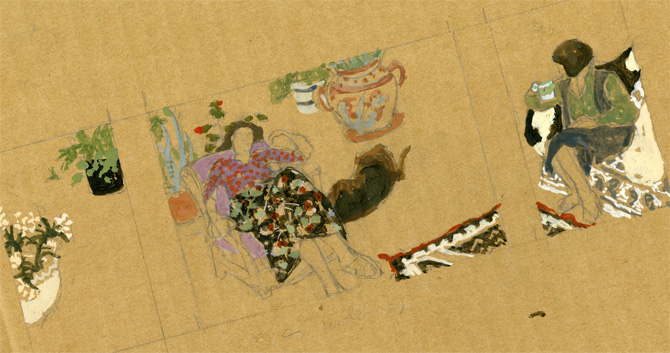
Rachel Levi ’15 was faced with an unusual dilemma last semester while choosing the subject of her final Core III project: too much information.
“I wanted to somehow incorporate my love of art and art history into my final project,” she says of online mini-archives produced as part of “Creating Archives,” a course taught by assistant professor of English Jacqueline Wernimont. Utilizing original research conducted in the Denison Library archives – and the advice of Judy Harvey Sahak, Denison’s director and Sallie Preston Swan Librarian – Levi chose Susan Hertel ’52 as her subject matter. Hertel was an accomplished artist who worked with Millard Sheets, artist and professor of art at Scripps College, as his assistant early in her career.
While Levi was limited to only 25 items in her archive, Denison’s collections held nearly twice that number of Hertel’s poems and sketches. In choosing what would make the cut, she discovered something amazing: some of the work had never been published.
“Thanks to her family, I was granted permission to ‘publish’ these documents and sketches in my archive,” Levi says. Fans of Hertel’s work may see these rare artifacts online thanks to Omeka, a digital exhibition platform.
Other students elected to break new ground with Scalar, another online archival system Scripps is privileged to use. In fact, Scripps is the only undergraduate institution in the country given access to the program, which is still in beta testing. Wernimont gained access through her work in a feminist technology effort with the Scalar team at USC, and because it’s still in testing and not widely available, the class had access to the designers.
“The day we learned how to use Scalar, I knew I had to try it,” says Jessica Ng ’15. “Its narrative emphasis appealed to me because I strive to establish a strong through-line in presentations.”
Ng’s archive documented the history of the Core curriculum at Scripps. She found a folder of alumnae letters from 1980 that were protesting changes in the Core humanities program, and decided to investigate how it developed.
“I don’t think I realized before this project how old Core is and how fundamental it has been to Scripps’ identity,” Ng said. “What could be more relevant for a Core project than its own history?”
Helenka Mietka ’15 also chose Scalar because of the rare opportunity to explore a medium so few people have access to. Intrigued by the power of the archivist in the selection process, Mietka worked with Sahak to chart the history of Henriette Alice Metcalf, whose son donated many books to Denison Library.
After searching for Metcalf’s name online, Mietka found two women with the same name; one lived in Paris in the 30s as a lesbian who broke social conventions and frequented the salon of Gertrude Stein, the other was a housewife married to a quasi-famous painter. Mietka found herself wishing the first, more “interesting” woman was the one she was searching for.
As it turns out, both women were one and the same, only at different stages of her life. “Professor Wernimont asked me to consider why I thought one woman was better or more interesting than the other,” says Mietka. “This lent a second element to my archive; not only did I want it to reflect the interesting life of Henriette, but also the journey I went through discovering it, the judgments I placed on the ‘different’ women, and how even a Scripps woman can fall into the trap of defining and judging a fellow woman’s life.”
Inspired, Mietka tricked the readers of her archive into initially believing that there were two Henriettes. While she never lied, she used the way she presented information to her benefit.
Beatriz Maldonado ’15 was also drawn to the value of archives in bringing history to the present – a key Core theme. Beatriz’s final project was “more of a personal concern instead of an academic one,” she says. Beatriz felt out of place and “wanted to find people or documents of proof of others going through the same thing I was going through.”
Beatriz eventually archived the Alexander Protests of 1993 to establish a Chicano/Latino Studies department, to give voice to another experience and group of people.
“The most rewarding experience was being able to go home and tell my parents, I created this project on the Internet,” Beatriz said. “I felt so accomplished using such high technology and such rich history and creating my story out of it.
“It may sound a bit too much, but I finally didn’t feel so alone in my Core III class.”

